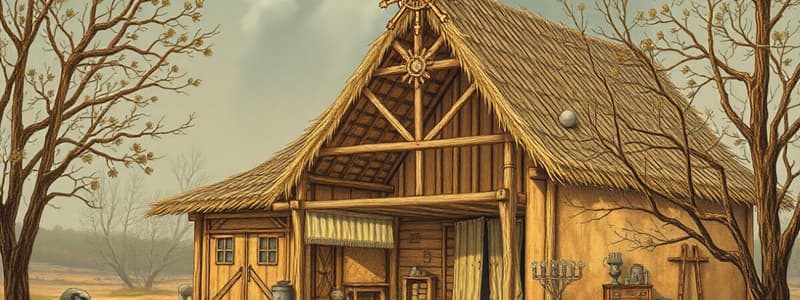Podcast
Questions and Answers
Which material was primarily used for making ancient bronze figures?
Which material was primarily used for making ancient bronze figures?
- Copper (correct)
- Silver
- Gold
- Iron
What is a key characteristic of the products made after World War I?
What is a key characteristic of the products made after World War I?
- They were solely made from wood.
- They were universally handmade.
- They were produced only for military purposes.
- They incorporated many materials of different properties. (correct)
What innovation significantly changed civilization as noted in the content?
What innovation significantly changed civilization as noted in the content?
- The war chariot
- The wheel (correct)
- The aqueduct
- The steam engine
Which structure is an example of Roman engineering mentioned in the content?
Which structure is an example of Roman engineering mentioned in the content?
What was a significant achievement of the Wright brothers in aviation?
What was a significant achievement of the Wright brothers in aviation?
In manufacturing different products, why is the selection of suitable materials crucial?
In manufacturing different products, why is the selection of suitable materials crucial?
What was a key function of the ancient warships mentioned?
What was a key function of the ancient warships mentioned?
Which ancient civilization is linked to the use of war chariots?
Which ancient civilization is linked to the use of war chariots?
What materials were combined to create the composite mud bricks used in Sumerian construction?
What materials were combined to create the composite mud bricks used in Sumerian construction?
What materials did early men primarily use to create tools?
What materials did early men primarily use to create tools?
Which process was used to create stronger and more durable kitchen utensils in ancient Mesopotamia?
Which process was used to create stronger and more durable kitchen utensils in ancient Mesopotamia?
Which materials were used by early men to build their permanent shelters?
Which materials were used by early men to build their permanent shelters?
What type of plough was used in ancient farming, which could be pulled by animals?
What type of plough was used in ancient farming, which could be pulled by animals?
What composite material did swallows use to build their nests?
What composite material did swallows use to build their nests?
What materials were primarily used to make sickles in ancient Egypt?
What materials were primarily used to make sickles in ancient Egypt?
What was a key change in human society about 10,000 years ago in Mesopotamia?
What was a key change in human society about 10,000 years ago in Mesopotamia?
What did ancient civilizations begin to use around 1550-1069 BC for tools and weapons?
What did ancient civilizations begin to use around 1550-1069 BC for tools and weapons?
Which components were required to produce mud bricks?
Which components were required to produce mud bricks?
Which agricultural tool was primarily used for turning the soil?
Which agricultural tool was primarily used for turning the soil?
What was NOT a characteristic of the materials used by early humans for tools and shelters?
What was NOT a characteristic of the materials used by early humans for tools and shelters?
What type of vessel is an example of stone shaping in ancient cultures?
What type of vessel is an example of stone shaping in ancient cultures?
Why was the ability to produce mud-brick significant to early agricultural societies?
Why was the ability to produce mud-brick significant to early agricultural societies?
What technique was not used for creating ceramic materials in ancient societies?
What technique was not used for creating ceramic materials in ancient societies?
Which statement about the materials used by early humans is incorrect?
Which statement about the materials used by early humans is incorrect?
Flashcards
Bronze Age technology
Bronze Age technology
The period when bronze tools and weapons were widely used.
Roman aqueducts
Roman aqueducts
Ancient Roman water-supply channels built for carrying water.
Wheel's impact on civilization
Wheel's impact on civilization
The invention of the wheel drastically changed human societies.
Early automobile
Early automobile
Signup and view all the flashcards
Industrial production
Industrial production
Signup and view all the flashcards
Suitable material (for products)
Suitable material (for products)
Signup and view all the flashcards
Product properties
Product properties
Signup and view all the flashcards
Ancient warship
Ancient warship
Signup and view all the flashcards
Evolution of transportation
Evolution of transportation
Signup and view all the flashcards
First successful flight
First successful flight
Signup and view all the flashcards
Mud Bricks
Mud Bricks
Signup and view all the flashcards
Mud Mortar/Plaster
Mud Mortar/Plaster
Signup and view all the flashcards
Ceramic Materials
Ceramic Materials
Signup and view all the flashcards
Sumerian Kitchen Utensils
Sumerian Kitchen Utensils
Signup and view all the flashcards
Ploughs
Ploughs
Signup and view all the flashcards
Sickles
Sickles
Signup and view all the flashcards
Stone Shaping
Stone Shaping
Signup and view all the flashcards
Bronze Age (Tools/Weapons)
Bronze Age (Tools/Weapons)
Signup and view all the flashcards
Early human needs
Early human needs
Signup and view all the flashcards
Natural materials
Natural materials
Signup and view all the flashcards
Early shelters
Early shelters
Signup and view all the flashcards
Mud brick creation
Mud brick creation
Signup and view all the flashcards
Settled agriculture
Settled agriculture
Signup and view all the flashcards
Bird's nest material
Bird's nest material
Signup and view all the flashcards
Human tools
Human tools
Signup and view all the flashcards
Materials timeline
Materials timeline
Signup and view all the flashcards
Study Notes
Why Do Men Need Materials?
- Human needs for materials are tied to survival and activities.
- Birds need food and a nest, while early humans needed food and shelter.
- Early humans needed tools for hunting, cutting, and chopping.
- Early humans used natural materials: stone, wood, bone, and fiber.
Homes of Early Man
- Early humans used caves, then built huts.
- Natural materials like stone, wood, reeds, and mud were used to create shelters.
- The building methods and materials were similar to those used by birds.
Man Begins Production
- Around 10,000 years ago, human settlements transitioned from hunter-gatherer societies to settled, agricultural ones.
- Early humans started growing crops like wheat and barley, and raising animals.
- Permanent shelters (houses) replaced temporary huts.
- Building materials, like mud bricks, were developed.
Making Mud Bricks
- To make mud bricks, molds, mud, and straw were needed.
- Wood was used to create the molds.
- A more watery mud mixture served as mortar and plaster.
- In some areas, petrol tar replaced mud for bonding.
Sumerian Kitchen
- Sumerian mud bricks were made from a mixture of riverbank clay, water, reeds, and straw.
- Reeds help bind the clay together, making a composite material.
Kitchen Utensils
- Early humans needed pots, pans, and plates to store and cook food.
- Containers of various shapes were essential for transporting food and crops.
- Clay was shaped and fired to create stronger, durable containers (ceramic items).
- Pottery (dishes), made from red pottery, were likely used to serve food (about 6,000 BC).
Farming Tools
- In Mesopotamia and Egypt, farming led to the development of ploughs.
- Ploughs were made from wood, stone, and fiber, with sharpened stones used as tips for digging soil.
- Sickles were used to harvest wheat and barley, made from wood and flint blades.
Shaping Stone
- People in the past shaped stone to create objects, like the Chlorite stone vase (22 cm high) from Tepe Yahya (2500 BC).
- This vase shows intricate overlapping patterns and bands of palm trees.
Using Metals
- Bronze (about 1550 to 1069 BC) became the main metal for tools, weapons, and everyday objects.
- Fishing hooks and arrowheads were made from bronze during this period.
- Gold rings (2025-1700 BC) and bronze figures (2025-1700 BC) were also created during this period.
Buildings of Later Civilizations
- Ancient structures like the Temple of Concordia, Roman aqueduct, Roman bridge, and Iron Bridge highlight continued development in building design and materials.
- Buildings used various materials, including stone, metal, and wood.
- Ships of ancient times and the 1906 HMS Dreadnought underscore technology advances
Civilizational Changes and Innovation
- The invention of the wheel was a major turning point in civilization.
- The development of different transportation methods from horse-drawn carriages to trains highlight advancements in materials and technology.
- The development of aircrafts and automobiles shows technology’s evolution, especially in the early 20th century.
Post-World War I
- After WWI, industrial production of materials broadened into textiles, machinery, railways, electricity, telecommunications, and transportation.
- Materials suitable for various components are now used in manufacturing. The suitability of materials is necessary for production purposes.
Today
- Modern life has complex needs for accommodation, feeding, transport, living, hobbies, education, communication, and defence.
- Products use a variety of materials with varied properties
- Today’s products utilize different types of materials carefully chosen for strength, durability, and efficiency.
Studying That Suits You
Use AI to generate personalized quizzes and flashcards to suit your learning preferences.




